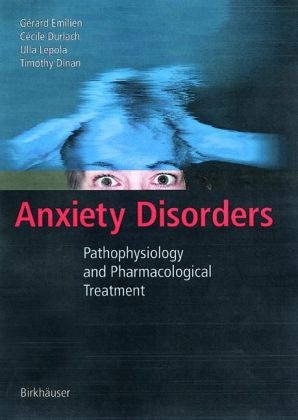Share
Fr. 134.00
Timothy Dinan, Cecil Durlach, Cecile Durlach, Gerar Emilien, Gerard Emilien, Ulla Lepola...
Anxiety Disorders - Pathophysiology and Pharmacological Treatment
English · Hardback
Shipping usually within 2 to 3 weeks (title will be printed to order)
Description
In this book, the discussion of the normal and pathological aspects of
anxiety is critically examined. A chapter on the molecular basis of
anxiety is included, outlining the potential of such approach in the
discovery of novel effective pharmacological interventions. The face
validity, predictability and usefulness of animal models in the design
of valid new efficacious products are discussed. Separate chapters
dedicated to each particular type of anxiety such as generalized anxiety
disorder, social phobia, posttraumatic stress disorder, panic and
obsessive-compulive disorder are included.
This book should be of benefit to psychiatrists, clinical psychologists,
general practitioners, nurses, students and all those engaged in
neuropsychiatric research.
List of contents
1:Normal and pathological anxiety.- 1 What is anxiety?.- 1.1 Anxiety in children.- 1.2 Anxiety in the elderly.- 1.3 Personality and anxiety.- 1.4 Cognitive aspects of anxiety.- 1.4.1 Gray neurophysiological model of anxiety.- 1.5 Comorbidity of anxiety disorders.- 1.6 Anxiety scales.- 2 Relevance of laboratory research on anxiety disorders.- 3 Genetic factors and brain imaging.- 4 Management.- 5 Discussion.- 2:Biological basis of anxiety and strategies for pharmacological innovation.- 1 Introduction.- 2 Neurobiology of anxiety disorders.- 2.1 Generalised anxiety disorder.- 2.2 Panic disorder.- 2.3 Social phobia.- 2.4 Post-traumatic stress disorder.- 2.5 Obsessive-compulsive disorders.- 3 Recent development and future anxiolytics.- 3.1 5-HT receptors.- 3.2 GABA receptors.- 3.3 Neuropeptide (CCK, CRF, NPY and NK) receptors.- 3.4 Glutamatergic pathways.- 3.5 Opioid receptors.- 3.6 Neurosteroids.- 3.7 Equilibrium between GABA-benzodiazepine and other receptors.- 3.8 Use of mutant mice.- 4 Discussion.- 3:Generalised anxiety disorder.- 1 Introduction.- 2 Diagnostic.- 3 The phenomenon of worry.- 4 Neurobiology.- 4.1 Imaging studies.- 4.2 Genetics.- 5 Physiopathology.- 6 Epidemiology and natural course.- 7 Treatment.- 7.1 Psychological.- 7.2 Biofeedback.- 7.3 Pharmacological.- 7.3.1 Benzodiazepines.- 7.3.2 Buspirone.- 7.3.3 Venlafaxine.- 7.3.4 SSRIs.- 7.3.5 Tricyclics.- 7.3.6 Other drugs.- 7.3.7 Algorithm for treatment.- 8 Methodology for clinical investigation.- 9 Discussion.- 4:Social phobia.- 1 Introduction.- 2 Diagnosis and comorbidity.- 2.1 Subtypes.- 2.2 Differential diagnosis.- 2.3 Comorbidity.- 2.4 Epidemiology.- 2.5 Natural history.- 2.6 Childhood and adolescence versus adult social phobia.- 3 Pathophysiology.- 3.1 Genetic.- 3.2 Neurophysiology.- 3.3 Neuroimaging.- 3.4 Environment.- 3.5 Gender and cultural differences.- 4 Treatments.- 4.1 Psychological.- 4.2 Pharmacological.- 4.3 Comparison, combination of drug versus cognitive-behavioral therapy.- 4.4 Algorithm for treatment.- 5 Methodology of clinical investigations.- 5.1 Rating scales.- 5.2 Self-assessment questionnaires.- 5.3 Clinician/computer-administered scales.- 5.4 Health Outcome Assessments.- 5.5 Assessment of recovery.- 6 Discussion.- 5:Panic disorder.- 1 Introduction.- 2 Diagnosis and aetiology.- 2.1 Comorbidity.- 2.2 Epidemiology.- 3 Pathophysiology.- 3.1 Autonomic and central nervous system dysfunctions.- 3.2 Brain imaging.- 3.3 Respiratory function and carbon dioxide sensitivity.- 3.4 Genetic.- 3.5 Impact on cognitive processes.- 4 Treatments.- 4.1 Psychological.- 4.2 Pharmacological.- 4.2.1 Benzodiazepines.- 4.2.2 Tricyclic antidepressants.- 4.2.3 SSRIs.- 4.2.4 Other treatments.- 4.2.5 Algorithm for treatment.- 5 Methodology for clinical investigation.- 5.1 Psychometric scales.- 5.2 Assessing response and remission.- 6 Discussion.- 6:Obsessive-compulsive disorder.- 1 Introduction.- 2 Diagnostic.- 2.1 Comorbidity.- 2.2 Epidemiology.- 2.3 Natural history.- 3 Physiopathology.- 3.1 Neurobiology.- 3.2 Brain imaging.- 3.3 Genetics.- 3.4 Cognitive dysfunctions.- 4 Treatment.- 4.1 Psychological treatment.- 4.2 Pharmacological treatment.- 4.2.1 Clomipramine.- 4.2.2 SSRI and the 5-HT receptors.- 4.2.3 Addition of atypical neuroleptics.- 4.2.4 Course of therapy.- 4.2.5 Children.- 4.2.6 Some cultural differences in treatment practice.- 5 Methodology for clinical investigation.- 5.1 Psychometric scales.- 6 Discussion.- 7:Posttraumatic stress disorder.- 1 Introduction.- 2 Epidemiology.- 3 Comorbidity.- 4 Physiological and neurological abnormalities associated with PTSD.- 4.1 Physiological abnormalities.- 4.2 Neurobiology and brain abnormalities.- 5 Cognitive dysfunction associated with PTSD.- 5.1 Assessment of PTSD.- 5.2 Attentional bias: The emotional Stroop test.- 5.3 Memory.- 6 Treatment of PTSD.- 6.1 Psychotherapeutic approach.- 6.1.1 Exposure therapy.- 6.1.2 Anxiety management programs.- 6.1.3 Cognitive therapy.- 6.1.4 Eye movement and desensitisation reprocessing.- 6
Summary
In this book, the discussion of the normal and pathological aspects of
anxiety is critically examined. A chapter on the molecular basis of
anxiety is included, outlining the potential of such approach in the
discovery of novel effective pharmacological interventions. The face
validity, predictability and usefulness of animal models in the design
of valid new efficacious products are discussed. Separate chapters
dedicated to each particular type of anxiety such as generalized anxiety
disorder, social phobia, posttraumatic stress disorder, panic and
obsessive-compulive disorder are included.
This book should be of benefit to psychiatrists, clinical psychologists,
general practitioners, nurses, students and all those engaged in
neuropsychiatric research.
Product details
| Authors | Timothy Dinan, Cecil Durlach, Cecile Durlach, Gerar Emilien, Gerard Emilien, Ulla Lepola, Ulla et al Lepola |
| Publisher | Springer, Basel |
| Languages | English |
| Product format | Hardback |
| Released | 01.01.2002 |
| EAN | 9783764367022 |
| ISBN | 978-3-7643-6702-2 |
| No. of pages | 298 |
| Weight | 840 g |
| Illustrations | 4 SW-Abb., XIX, 298 p. |
| Subjects |
Humanities, art, music
> Psychology
> Theoretical psychology
Natural sciences, medicine, IT, technology > Medicine > Clinical medicine |
Customer reviews
No reviews have been written for this item yet. Write the first review and be helpful to other users when they decide on a purchase.
Write a review
Thumbs up or thumbs down? Write your own review.

